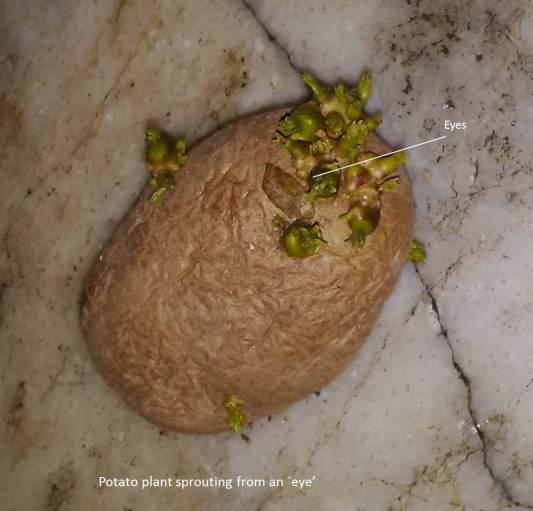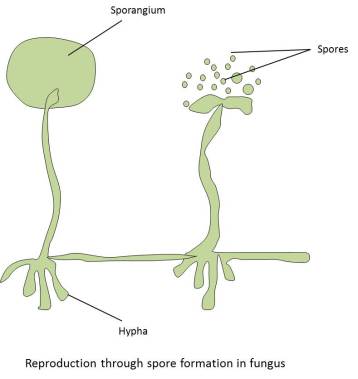Notes of chapter: Reproduction in Plants are presented below. Indepth notes along with worksheets and NCERT Solutions for Class 7.
(1) Reproduction-
The production of new individuals from their parents is known as reproduction.
(2) Vegetative parts-
Roots, stems and leaves are called vegetative parts of a plant.
(3) Flowers-
Flowers are the reproductive parts of the plant. A flower may have either the male part or the female part or both male and female parts.
(4) Plants produce their offspring by many ways but these are categorised in to two types which are given below-
(i) Asexual reproduction
(ii) Sexual reproduction
(5) Asexual reproduction-
When new plants are obtained without production of seeds, the reproduction of plants is known as asexual reproduction.
Types of asexual reproduction are given below-
(i) Vegetative propagation
(ii) Budding
(iii) Fragmentation
(iv) Spore formation
(6)Vegetative propagation-
When reproduction of the plants is happen through vegetative parts of plant such as stem, leaves, roots and buds, it is known as vegetative propagation.
(i) A node is a part of the stem/branch at which a leaf arises.
(ii) The piece of branch with a node is called cutting.
Experiment 1
Take a cutting of rose. Bury the cutting in the soil. Water it every day. After 7-8 days you will see new leaves arise.
(iii) An axil, in the plant, is a point of attachment of the leaf at the node.
(iv) The buds (other than flower bud) grow in the axil of leaves which develop into shoots are known as vegetative buds. These buds consist of a short stem around which immature overlapping leaves are folded. The vegetative buds can give rise to new plants.

(v) The potato eyes are the buds which grow new plant.
Experiment 2
Cut a few pieces of potato, each with an eye. Bury them in the soil. Water the pieces regularly. After 3-4 days new eyes will come out. Turmeric and ginger can grow win the same way.

(vi) Bryophyllum (sprout leaf plant) has buds in the margins of leaves. The buds of leaf of this plant can give rise to a new plant if the leaf falls on a moist soil.

(vii) The roots of some plants can also give rise to new plants.
Eg:– Sweet potato and dahlia
(viii) Some plants can produce new plants when their parts get detached from the main plant body. Each detached part can grow into a new plant.
Eg:– Cacti
(ix) Plants produced by vegetative propagation take less time to grow and bear flowers and fruits earlier than those produced from seeds.
(x) The new plants from vegetative propagation are produced from a single parent and they are exact copies of their parent plant.
(7) Budding-
The small bulb like projection coming out from the yeast cell is called a bud. The bud gradually grows and gets detached from the parent cell and forms a new yeast cell. Sometimes, another bud arises from the bud forming a chain of buds. If this process continues, a large number of yeast cells are produced in a short time.
Experiment 3
Take a pinch of yeast powder and place it in a container with some water. Add a spoonful of sugar and shake well to dissolve sugar. Keep it in a warm part of a room. After an hour, put a drop of this liquid on a glass slide and observe under a microscope. You can see the formation of new yeast cells which is shown in figure below.

(8) Fragmentation-
Fragmentation is the process of reproduction in which an organism split into fragments which grow and develop as mature individuals that are clone of their parent organism.
Eg:- Algae.
Algae are easily found in stagnant water. When water and nutrients available to algae, they breaks up into two or more fragments which grow as new individuals. They cover a large area in a short period of time.

(9) Spore formation-
Spore formation is the mode of reproduction of fungi by spores, which are asexual reproductive bodies. Each spore is covered by a hard protective coat to withstand unfavourable conditions such as high temperature and low humidity. So, they can survive for a long time. Under favourable conditions, a spore germinates and develops into a new individual.
Eg: – moss and ferns

(10) Sexual reproduction-
When male reproductive part (stamen) and female reproductive part (pistil) unite to reproduce new plant which is not necessarily identical to their parents, is known as sexual reproduction in plants.
(i) Unisexual flowers-
The flowers which contain either only the pistil or only the stamens are called unisexual flowers. Both the male and the female unisexual flowers may be present in the same plant or in different plants.
Eg:– corn, papaya and cucumber.
(ii) Bisexual flowers-
The flowers which contain both stamens and pistil are called bisexual flowers.
Eg: – mustard, rose and petunia.
(11) Reproductive parts of the flower-
Experiment 4
Take mustard/ china rose/petunia flower and separate its reproductive parts. Study the various parts of a stamen and pistil.
(i) Stamen-
Stamen, the male part of the plant consists two parts, i.e., anther and filament.
(ii) Anther-
Anther contains pollen grains which produce male gametes.

(iii) Pistil-
Pistil, the female part of the plant consists three parts, i.e., stigma, style and ovary. The ovary contains one or more ovules which formed female gamete or the egg. Stigma is a part where pollen germinates.

(12) Pollination-
The transfer of pollen from the anther to the stigma of a flower is called pollination.
Pollen grains are light and have tough protective coat which prevent them from drying up. Pollen grains can be carried by wind, water and insects. When insects visit flower they carry away some pollen on their bodies. Some of the pollen land on the stigma of a flower of same kind.
Types of pollination-
(i) Self – pollination-
If the pollen lands on the stigma of the same flower it is called self- pollination.

(ii) Cross -pollination-
When the pollen of a flower lands on the stigma of another flower of the same plant, or that of a different plant of the same kind, it is called cross – pollination.

(13) Fertilisation-
The process of fusion of male and female gametes (to form a zygote) is called fertilisation.

(14) The cell which results after fusion of the gametes is called a zygote. It develops into an embryo.
(15) After fertilization, the ovary grows into a fruit and other parts of the flower fall off. The fruit is the ripened ovary.
(16) The seed develop from the ovules. The seed contains an embryo enclosed in a protective seed coat.
(17) Same kind of plants grows at different places because seed dispersed to different places. Thus, seed dispersal is a transportation of seeds away from parent plant.
Seed dispersed by various ways which are given below-
(i) Seeds blown away by wind.
Eg:- Winged seeds such as drumstick and maple, light seeds of grasses or hairy seeds of aak and hairy fruit of sunflower.
(ii) Some seeds are dispersed by water. These seeds or fruits develop floating ability in the form of spongy or fibrous outré coat.
Eg:- coconut
(iii) Some seeds are dispersed by animals. Spiny seeds with hooks get attached to the bodies of animals and are carried to distant places.
Eg:- Xanthium and Urena.
(iv) Some seeds are dispersed when the fruits burst with sudden jerks. The seeds are scattered far from the parent plant.
Eg:- castor and balsam.
(18) Seed dispersal helps the plants to
(i) prevent overcrowding
(ii) avoid competition for sunlight, water and minerals
(iii) invade new habitats.
Helping Topics